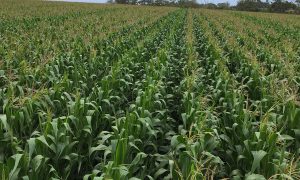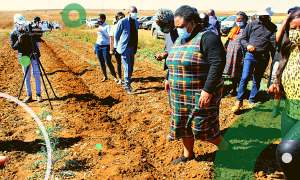Mzansi Agri Talk held a conversation with Pasture Scientist Nolubabalo Tshwati, regarding her research project titled “Effect of Phosphorus application on dry matter yield and nutrient content of Mucuna Pruriens (L) in Alice, Eastern Cape, South Africa”.
Tshwati graduated with masters of Science Agriculture – Pasture Science from Fort Hare University and is currently employed at Mabalengwe Agriculture as a Junior Researcher.
In the interview we focused on what is planted pasture and its economic and ecological benefits. We were mindful that It is every crop farmer’s dream to harvest high quality produce, season after season and also, to farm with nature.
So, in order to achieve this, soil management has to be a farmer’s top priority. One of the reasons a farmer could end up with poor crops yield is soil depletion, which is mostly due to excessive intense cultivation and inadequate soil management.
Depletion occurs when components which contribute to fertility are removed and not replaced and the conditions which support soil fertility are not maintained.
So, it’s crucial for every farmer to embark on soil fertility management.
Tshwati demonstrated in her final dissertation that the use of herbaceous legumes Mucuna (Mucuna Pruriens) can assist to recapitalise soil fertility depletion while at the same time improving livestock productivity in the small holder farming sector of South Africa.
The objective of her study was to investigate the effect of phosphorus fertilizer application on dry matter yield and nutritive value of Mucuna pruriens.
The study was conducted at University of Fort Hare Research farm in Alice, South Africa. The research design was a randomized complete block design with three replicates per treatment. Data collection included biomass production and nutrient content of Mucuna pruriens. The forage legume was harvested at flowering stage of growth and analysed for chemical composition.
The results showed that with the application of 60 kg P/ha Mucuna had the highest (P < 0.05) fresh and dry matter yield of 19.58 kg/ha and 5.41 kg/ha, respectively compared to other treatments. However, all the other treatments differed from one another.
Similarly, the fresh stem and leaf fractions yield and their dry matter yields showed the same trend with application of 60 kg P/ha having the greatest yield compared to the other treatments.
Nevertheless, all the treatments differed (P<0.05) from one another with PO having the least yields.
The research found that the leaf to stem ratio did not show any significant (P>0.05) difference among all the treatments ranging from 1.44 to 1.62 in fresh forage and ranging from 1.31 to 1.50 in the dry forage. In terms of dry matter content, the control treatment had the highest dry matter content of 37.78%, however, all the other treatments did not differ significantly (P < 0.05) from each other.
There was no significant effect of P application (P >0.05) in terms of ash, EE, ADF, CP, Ca, Mg, K, Na, P, Zn, Cu, Mn and Fe of the whole plant forage among the treatments. The application of 40 kg P/ha fertilizer significantly (P < 0.05) increased the NDF (51.16%) of the whole plant of Mucuna compared to the other treatments which did not differ (p>0.05) among themselves. Within the stem fraction there were no significant (P >0.05) differences among Scanned with CamScanner the treatments for the ash, EE, ADF, NDF, and CP, hemicellulose, Ca, Mg, K, P, Zn, Cu, Mn and Fe contents.
However, the application of 40 kg P/ha fertilizer significantly (P < 0.05) increased the Na (0.05%) content of the Mucuna stem fraction. In the leaf fraction of Mucuna there was no significant (P >0.05) differences in terms of ash, EE, ADF, NDF, CP, hemicellulose, Ca, K, P, Zn, Cu, Mn and Fe among the treatments. However, the application of 20 kg P/ha fertilizer significantly (P <0.05) increased the Mg (0.52%) of the Mucuna leaves compared to the other treatments.
Therefore, the study has shown that increase in P application (60 kg P/ha) has no major effect in the nutrient content of Mucuna. Furthermore, it is recommended that Mucuna can be grown as a protein supplement, based on the CP content values that were recorded in this study and to provide maintenance requirements for ruminants.
It was therefore concluded that phosphorus fertilization particularly 60 kg P/ha is necessary and required for optimum growth of Mucuna pruriens in order to increase forage yield. Based on the nutrient content result it was concluded that there was no effect of P fertilizer application levels on the nutrient content of Mucuna pruriens in Alice.
Tshwati’s short to medium plan is to assist farmers in communal setups (commonage) to apply the best veld management systems to reduce the current overgrazing in rural communities.




















